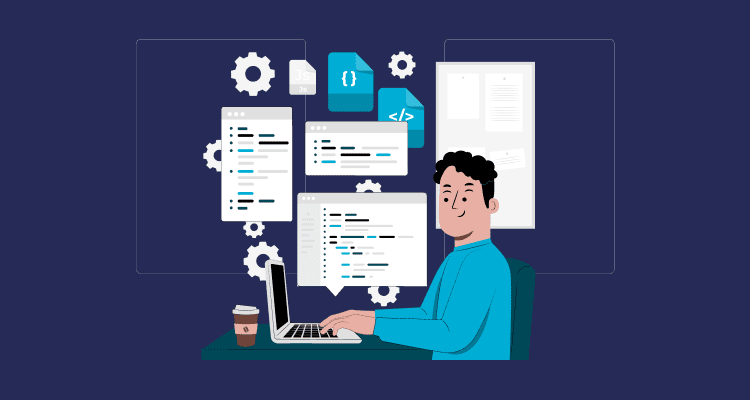Did you know building an application is no longer time-consuming and difficult for developers now? Automation in app building is increasing day to day.
Low-code and no-code development platforms simplified the application development process for industries. Low-code development platforms have a visual drag-and-drop interface. It makes customized software development easy for low-skilled developers.
What are Low-Code and No-Code Platforms?
With low-code development, developers don’t need to write much detailed code line by line to make an app. It helps speed up making apps. People who know little about coding can develop apps using simple visuals and readymade templates. These tools let more people out of the IT sector to start building applications, so they can build and test applications by themselves without knowing more about coding.
Low-code and no-code development offer ready-to-use templates and easy-to-drop elements, making it quick and simple to create products. It helps to manage content and development without needing a perfectly skilled developer from time to time.
Advantages of Low-Code and No-Code Development
When we talk about the advantage of it is that it makes apps in less time. Developers can create apps faster than traditional coding using readymade templates and visual development tools. Here are other advantages:
- Reduces the need for specialized coding skills and helps IT and non-tech teams work together.
- Low-code and no-code let organizations try out new ideas without spending much upfront.
- Using readymade templates and visuals lowers the chance of coding mistakes.
- These platforms often let you add more features and user friendly app creation.
- No-code platforms especially let regular users become developers.
- This means they can make functional apps for their needs without relying on IT experts.
Observability in low-code/no-code platforms is crucial for understanding and optimizing the performance of applications. By enhancing visibility into the underlying processes, data flows, and user interactions, observability empowers developers using these platforms to identify bottlenecks, troubleshoot issues, and iteratively improve application functionality without traditional coding, fostering a more efficient and user-centric development process.
Low-code and no-code development bring efficiency to software development. It is accessible to small industries and businesses to save on budgets.
Industries Embracing Low-Code and No-Code
Making apps with low-code and no-code is super easy and fun for many industries. It helps quickly make apps for customers and keeps everything compliant. In healthcare, it’s used for patient information and data, even by people who don’t code often. Manufacturing industries use these tools to manage supplies and work better.
Low-code and no-code help make apps fast so businesses can keep up with customers’ wants. Governments use them for services that people need, making things better for everyone. The energy sector uses them for managing things and looking at data, showing how useful they are in many different areas. This technology is empowering business users.
Challenges and Limitations of Low-Code/No-Code
Every time, accepting new technologies leads to some difficulties. In term of using low-code and no-code development creates some problems:
- Low-code and no-code platforms, designed for simplicity, can still have a learning curve.
- In such cases, traditional coding may be necessary for a perfect solution in the application.
- This can lead to performance issues as applications become complex or user volume increases.
- The rapid development facilitated by these platforms may result in security oversights.
- Adopting specific low-code or no-code platforms may create dependency on a particular vendor’s ecosystem.
These terms most cause difficulties in such development. Improvements with new technologies make it easy and helpful to use.
Future Outlook for Low-Code/No-Code Development
New development technologies fill the future of low-code and no-code application development platforms. We expect these methods to become even more popular in different industries. These tools may get even better with artificial intelligence and machine learning. This means developers can personalize and tweak their apps. These platforms might work even more smoothly with DevOps practices, connecting with other tools.
Developers are focused on making sure that these platforms are safe and follow the rules. They’re also trying hard to involve more people in the development process. We might also see more tools to help developers work together and share their knowledge. In short, the future is full of changes, making low-code and no-code development essential to creating software.
The Impact on Traditional Software Development
Building software is changing with low-code and no-code methods. They help make apps faster and let non-tech people in their industries. This teamwork is good, but these methods might not replace traditional coding in tricky situations. Skilled developers are still crucial for complex tasks. Low-code and no-code are helpful, but traditional ways are still important. They work together to speed up the development process, choosing what’s needed for each project.
Conclusion: The Evolution of Software Development
Developing software with low-code and no-code methods brings speed. These approaches customize software development easily. But it’s essential to know they only partially replace traditional coding.
Looking ahead, traditional and low-code/no-code methods give organizations a versatile toolkit. Things are changing, and it’s not just about new tools. How we work is evolving to be more team-oriented, flexible, and easy to use. Accepting this change helps businesses innovate quickly and stay competitive in technology.



































